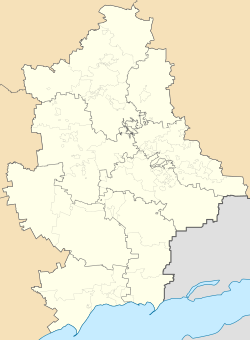HD 16754
HD 16754| 관측 데이터 에폭 J2000 이쿼녹스 J2000 | |
|---|---|
| 별자리 | 에리다누스 |
| 우측 상승 | 02h 39m 47.96544s[1] |
| 탈위임 | −42° 53′ 30.3638″[1] |
| 겉보기 크기 (V) | +4.74[2] |
| 특성. | |
| 스펙트럼형 | A1 Vb[3] + M2-5V[4] + ? |
| B-V색지수 | 0.061±0.003[2] |
| 아스트로메트리 | |
| 방사 속도 (Rv) | +18.0±4.2km[2]/s |
| 고유 운동 (μ) | RA: +88.20[5]mas/yr Dec.: −17.82[5]mas/yr |
| 시차 (π) | 24.7076 ± 0.3930[1] 마스 |
| 거리 | 132 ± 2 리 (40.5 ± 0.6 pc) |
| 절대치수 (MV) | +1.76[6] |
| 세부 사항 | |
| Aa | |
| 미사 | 1.95[7] M☉ |
| 반지름 | 1.93[8] R☉ |
| 루미도 | 17.44[2] L☉ |
| 표면 중력 (log g) | 4.40±0.14[7] cgs |
| 온도 | 9,099±309[7] K |
| 금속성 [Fe/H] | -0.06[3] 덱스 |
| 회전 속도 (v sin i) | 167.6±1[9].7 또는 13.4±1.5km[6]/s |
| 나이 | 212나[7] 30Myr[8]. |
| 기타 지정 | |
| 데이터베이스 참조 | |
| 심바드 | 자료 |
HD 16754는 에리다누스자리에 있는 2진수[11] 또는 3진수[8] 항성계통이다.바이엘은 에리다니라는 이름을 가지고 있으며, HD 16754는 헨리 드레이퍼 카탈로그의 이름이다.이 시스템은 육안으로 볼 때 가시적 크기가 +4.74인 희미한 빛의 지점으로 보인다.[2]시차를 기준으로 태양으로부터 약 132광년 거리에 위치해 있으며,[1] 방사상 속도 +18 km/s로 더 멀리 떠내려가고 있다.[2]이 시스템은 공동 움직이는 스타들의 컬럼바 협회의 회원이다.[12]
이 물체는 히파르코스 우주선에서 이루어진 적절한 움직임 측정을 기반으로 하여 천체 이항성으로 플래그 지정되었다.[13][14]주커만 외 연구진(2011년)은 북쪽으로 25㎞의 각진격차로 밝은 A형 1차 + 희미한 M형 동반자가 있는 멀티스타 시스템으로 간주한다.그 예비선거의 천문학적 동반자는 여전히 미해결인 채로 남아 있다.[8]
주성분은 A형 주계열성으로 별 분류가 A1 Vb이다.[3]별난 모델들을 바탕으로, 그것은 2억 1천 2백만 년으로 추정되는 나이를 가지고 있다.[7]콜럼바 협회의 회원들과 일치한다는 것은 훨씬 더 어린 나이인 3천만년을 암시한다.[8]초기 측정에서는 168km/s의 높은 예상 회전 속도를 보였다.[9]그러나 Amler-von Eiff and Reiners(2012년)는 13km/s의 훨씬 낮은 속도를 발견했다.[6]
눈에 보이는 동반자는 M2-5V 범위의 클래스를 가진 적색 왜성이다.이 시스템은 924×1020 W의 광도를 가진 X선 방출의 원천으로, 이 구성 요소와 미해결 동반자에서 발생할 가능성이 가장 높다.[4]
참조
- ^ a b c d Brown, A. G. A.; et al. (Gaia collaboration) (August 2018). "Gaia Data Release 2: Summary of the contents and survey properties". Astronomy & Astrophysics. 616. A1. arXiv:1804.09365. Bibcode:2018A&A...616A...1G. doi:10.1051/0004-6361/201833051.이 소스에 대한 가이아 DR2 기록 VizieR.
- ^ a b c d e f Anderson, E.; Francis, Ch. (2012), "XHIP: An extended hipparcos compilation", Astronomy Letters, 38 (5): 331, arXiv:1108.4971, Bibcode:2012AstL...38..331A, doi:10.1134/S1063773712050015, S2CID 119257644.
- ^ a b c Gray, R. O.; et al. (July 2006), "Contributions to the Nearby Stars (NStars) Project: spectroscopy of stars earlier than M0 within 40 pc-The Southern Sample", The Astronomical Journal, 132 (1): 161–170, arXiv:astro-ph/0603770, Bibcode:2006AJ....132..161G, doi:10.1086/504637, S2CID 119476992.
- ^ a b Schröder, C.; Schmitt, J. H. M. M. (November 2007), "X-ray emission from A-type stars", Astronomy and Astrophysics, 475 (2): 677–684, Bibcode:2007A&A...475..677S, doi:10.1051/0004-6361:20077429.
- ^ a b van Leeuwen, F. (2007), "Validation of the new Hipparcos reduction", Astronomy and Astrophysics, 474 (2): 653–664, arXiv:0708.1752, Bibcode:2007A&A...474..653V, doi:10.1051/0004-6361:20078357, S2CID 18759600.
- ^ a b c Ammler-von Eiff, Matthias; Reiners, Ansgar (June 2012), "New measurements of rotation and differential rotation in A-F stars: are there two populations of differentially rotating stars?", Astronomy & Astrophysics, 542: A116, arXiv:1204.2459, Bibcode:2012A&A...542A.116A, doi:10.1051/0004-6361/201118724, S2CID 53666672.
- ^ a b c d e David, Trevor J.; Hillenbrand, Lynne A. (2015), "The Ages of Early-Type Stars: Strömgren Photometric Methods Calibrated, Validated, Tested, and Applied to Hosts and Prospective Hosts of Directly Imaged Exoplanets", The Astrophysical Journal, 804 (2): 146, arXiv:1501.03154, Bibcode:2015ApJ...804..146D, doi:10.1088/0004-637X/804/2/146, S2CID 33401607.
- ^ a b c d e Zuckerman, B.; et al. (May 2011), "The Tucana/Horologium, Columba, AB Doradus, and Argus Associations: New Members and Dusty Debris Disks", The Astrophysical Journal, 732 (2): 61, arXiv:1104.0284v1, Bibcode:2011ApJ...732...61Z, doi:10.1088/0004-637X/732/2/61, S2CID 62797470.
- ^ a b Díaz, C. G.; et al. (July 2011), "Accurate stellar rotational velocities using the Fourier transform of the cross correlation maximum", Astronomy & Astrophysics, 531: A143, arXiv:1012.4858, Bibcode:2011A&A...531A.143D, doi:10.1051/0004-6361/201016386, S2CID 119286673.
- ^ "HD 16754". SIMBAD. Centre de données astronomiques de Strasbourg. Retrieved 2019-12-16.
- ^ Eggleton, P. P.; Tokovinin, A. A. (September 2008), "A catalogue of multiplicity among bright stellar systems", Monthly Notices of the Royal Astronomical Society, 389 (2): 869–879, arXiv:0806.2878, Bibcode:2008MNRAS.389..869E, doi:10.1111/j.1365-2966.2008.13596.x, S2CID 14878976.
- ^ Elliott, P.; et al. (May 2016), "Search for associations containing young stars (SACY). VII. New stellar and substellar candidate members in the young associations", Astronomy & Astrophysics, 590: 28, arXiv:1604.03550, Bibcode:2016A&A...590A..13E, doi:10.1051/0004-6361/201628253, S2CID 53138126, A13.
- ^ Makarov, V. V.; Kaplan, G. H. (May 2005), "Statistical Constraints for Astrometric Binaries with Nonlinear Motion", The Astronomical Journal, 129 (5): 2420–2427, Bibcode:2005AJ....129.2420M, doi:10.1086/429590.
- ^ Frankowski, A.; et al. (March 2007), "Proper-motion binaries in the Hipparcos catalogue. Comparison with radial velocity data", Astronomy and Astrophysics, 464 (1): 377–392, arXiv:astro-ph/0612449, Bibcode:2007A&A...464..377F, doi:10.1051/0004-6361:20065526, S2CID 14010423.


